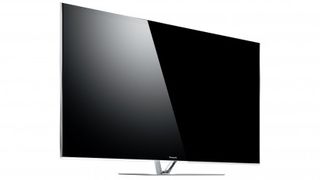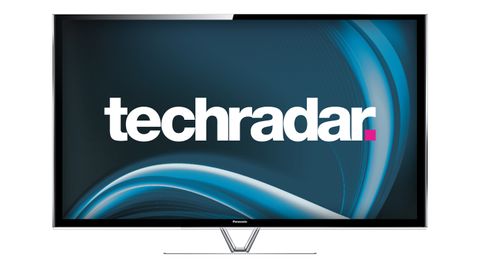Why you can trust TechRadar
With TV picture standards rising across the board this year, it's become much harder for any new model to really blow us away right from the get-go. But the Panasonic TX-P50VT65 manages it. With knobs on.
Given our expectations that the Panasonic TX-P50VT65 has been designed to be particularly effective with films, to suit serious home cinema fans, we fed it a selection of our favourite and most technically demanding Blu-rays. And for every second of every title we tried, the Panasonic TX-P50VT65's pictures looked nothing short of exquisite.
Predictably, the foundation to the Panasonic TX-P50VT65's exceptional image prowess is its black level response. This achieves a black depth and tonal naturalism when showing dark scenes, the like of which we haven't witnessed since Pioneer launched the last of its impossibly-ahead-of-their-time KURO plasma TVs. This fact alone will send tingles down the spines of long-term AV technology fans.

Black levels manage to go even deeper than those of the Samsung PS64F8500, despite the truly huge black level improvements Samsung has managed to deliver this year. In fact, there are times where the Panasonic TX-P50VT65's black levels actually look deeper than those of the KURO reference set we've still got set up in our test room.
It's important to stress, too, that the Panasonic TX-P50VT65's staggering black level performance isn't in any way forced. Tucked safely away in even the darkest corners of the Panasonic TX-P50VT65's images are the tiniest and most subtle of colour tones and shadow details. This is a result of the fact that plasma technology produces the light output for each of its pixels individually, rather than having to depend on external light sources that must 'compromise' their light levels to achieve the best balance to satisfy the mixture of bright and dark elements that make up all pictures.
It's brilliant to find, too, that the depth of the Panasonic TX-P50VT65's black levels is joined by a beautifully neutral black tone, with practically zero sign of the blue or green undertone that's been visible with many previous plasma TVs.

Black levels as brilliant as those delivered by the Panasonic TX-P50VT65 aren't just great in their own right. They also provide a spectacular point of contrast for the screen's colours to work against. This means that colours look more dynamic as well as - more importantly - gorgeously natural, with tones that really can look all but identical to those you might hope to see emerging from a commercial-grade digital projector at your local cinema.
HD picture processing
The quality of the panel and power of Panasonic's latest Hexa picture processing engine, moreover, ensures that colours appear on the Panasonic TX-P50VT65 with stunning levels of tonal accuracy and blend subtlety. This infuses HD images with so much finesse and colour nuancing that they resemble with uncanny accuracy the sort of immaculate and immersive images you get from celluloid or digital images projected at a higher resolution than the 1920 x 1080 setup of the Panasonic TX-P50VT65's panel.
It does no harm to the Panasonic TX-P50VT65's sense of extreme image sharpness, either, that its pictures look beautifully crisp and detailed without tipping over into becoming noisy.

What's more, motion is handled far better on the Panasonic TX-P50VT65 than it has been on any previous Panasonic plasma TV we've seen, combining plasma's innate freedom from motion blur (compared with LCD TVs) with markedly less judder or stutter than we've previously seen with Panasonic plasmas.
During fast camera pans there's still a very faint trace of double imaging around strongly defined edges, but it's much less of an issue than it has been before, and can be largely eradicated if you call into play Panasonic's Intelligent Frame Creation motion processing. Many film enthusiasts won't want to do this, because even on its lowest power level it can cause a slightly video-like look to creep into proceedings. But it does at least avoid generating many of the flickering or haloing issues of many motion processing systems.
Now that we've stumbled across a small negative aspect to the Panasonic TX-P50VT65's 2D picture performance, we might as well hunt for more - however ill-rewarded that hunt might be.

Probably the main point to stress is that the Panasonic TX-P50VT65 is at its best when you're not running it very brightly. Push the brightness too high and the image starts to suffer with green speckling noise in dark parts of the picture (a problem also witnessed on Samsung's PS64F8500).
This need to keep a lid on the set's brightness perhaps dents the Panasonic TX-P50VT65's appeal to people who spend most of their time in very bright rooms. But at the same time, the green speckling loses its impact the further from the screen you're sat, so if your room is reasonably big you may well not feel troubled by the dithering even when running the screen very hard.
3D pictures
Before dragging ourselves away from the Panasonic TX-P50VT65's gorgeous pictures, there's still the small matter of its 3D picture quality to consider. And happily the Panasonic TX-P50VT65's quality largely remains intact in the third dimension.
Particularly impressive is the screen's almost total freedom from crosstalk ghosting noise, and the amount of detail you can see when watching 3D Blu-rays.

The Panasonic TX-P50VT65's phenomenal contrast helps the screen build a terrific sense of 3D space too, and unlike some previous Panasonic plasmas we've seen, 3D motion is credibly handled, with only a small increase in the double edging phenomenon noted earlier.
The only concern in 3D mode is that as per usual, Panasonic's active shutter 3D glasses cause what feels like a more substantial reduction in brightness than you see with most rival 3D platforms.
But so long as you can darken your room for 3D viewing, this loss of brightness isn't too severe a price to pay for all the good things about the Panasonic TX-P50VT65's 3D pictures. It's worth adding, too, that the Panasonic TX-P50VT65's 3D pictures are brighter than those seen on any previous Panasonic 3D plasma TV.
AV Technology Contributor
John has been writing about home entertainment technology for more than two decades - an especially impressive feat considering he still claims to only be 35 years old (yeah, right). In that time he’s reviewed hundreds if not thousands of TVs, projectors and speakers, and spent frankly far too long sitting by himself in a dark room.


